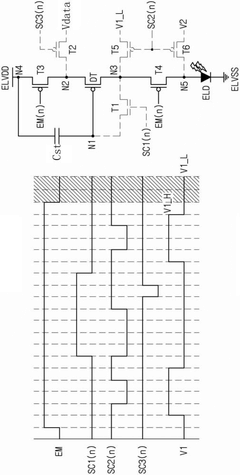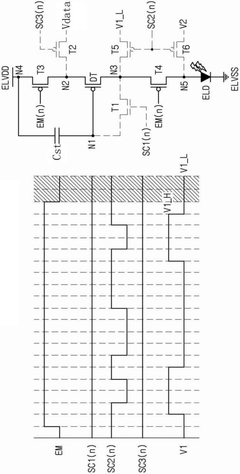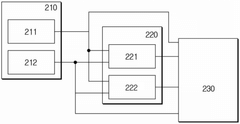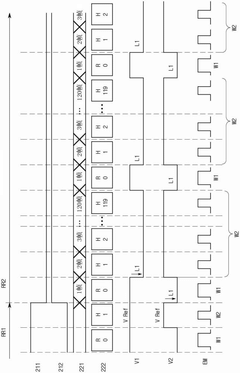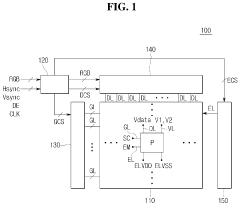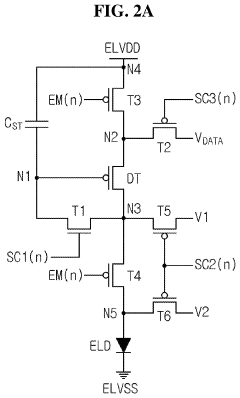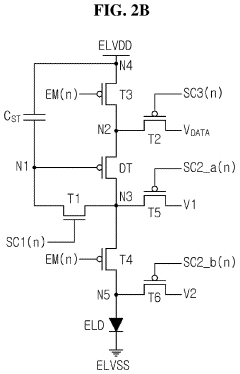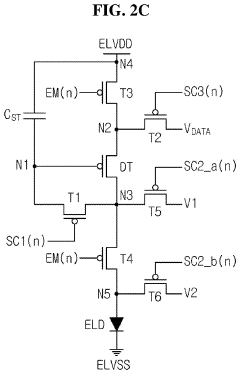Sustainability Gains with VRR in e-Ink Technologies
SEP 24, 20259 MIN READ
Generate Your Research Report Instantly with AI Agent
Patsnap Eureka helps you evaluate technical feasibility & market potential.
E-Ink VRR Technology Background and Objectives
Electronic ink (e-ink) technology has evolved significantly since its commercial introduction in the early 2000s. Initially developed as a low-power alternative to traditional display technologies, e-ink displays have been primarily valued for their paper-like reading experience and minimal power consumption. The technology operates on the principle of electrophoresis, where charged particles move in response to an electric field, creating visible patterns without requiring constant power to maintain an image.
Over the past decade, e-ink displays have progressed from simple monochrome screens to advanced color displays with improved refresh rates and resolution. However, one persistent limitation has been the relatively slow refresh rate compared to LCD or OLED technologies, restricting e-ink applications primarily to e-readers and static information displays.
Variable Refresh Rate (VRR) represents a significant technological advancement in display technology, allowing screens to dynamically adjust their refresh frequency based on content requirements. While VRR has become standard in gaming monitors and premium smartphones to balance performance and power efficiency, its implementation in e-ink technology presents unique challenges and opportunities.
The integration of VRR into e-ink displays aims to address several critical limitations while maintaining the technology's core sustainability advantages. The primary technical objective is to develop an adaptive refresh system that can intelligently vary between ultra-low power states for static content and higher refresh rates for dynamic content, without compromising the fundamental power efficiency that makes e-ink valuable.
Current e-ink displays typically operate at fixed refresh rates between 1-15 Hz, significantly lower than the 60-120 Hz common in conventional displays. The technical goal is to create a system capable of dynamically scaling between sub-1 Hz for static content to potentially 30+ Hz for interactive elements, while maintaining the near-zero power consumption during static display periods.
From a sustainability perspective, this technological evolution seeks to expand e-ink applications beyond current niches into more mainstream computing devices, potentially replacing energy-intensive conventional displays in various use cases. The environmental impact could be substantial, as display components typically account for 30-50% of a mobile device's energy consumption.
The convergence of VRR and e-ink technologies represents a promising frontier in sustainable computing, potentially enabling a new generation of devices that combine interactive capabilities with dramatically reduced energy footprints. This technical direction aligns with growing market and regulatory pressure for more energy-efficient electronic devices and circular economy principles in technology design.
Over the past decade, e-ink displays have progressed from simple monochrome screens to advanced color displays with improved refresh rates and resolution. However, one persistent limitation has been the relatively slow refresh rate compared to LCD or OLED technologies, restricting e-ink applications primarily to e-readers and static information displays.
Variable Refresh Rate (VRR) represents a significant technological advancement in display technology, allowing screens to dynamically adjust their refresh frequency based on content requirements. While VRR has become standard in gaming monitors and premium smartphones to balance performance and power efficiency, its implementation in e-ink technology presents unique challenges and opportunities.
The integration of VRR into e-ink displays aims to address several critical limitations while maintaining the technology's core sustainability advantages. The primary technical objective is to develop an adaptive refresh system that can intelligently vary between ultra-low power states for static content and higher refresh rates for dynamic content, without compromising the fundamental power efficiency that makes e-ink valuable.
Current e-ink displays typically operate at fixed refresh rates between 1-15 Hz, significantly lower than the 60-120 Hz common in conventional displays. The technical goal is to create a system capable of dynamically scaling between sub-1 Hz for static content to potentially 30+ Hz for interactive elements, while maintaining the near-zero power consumption during static display periods.
From a sustainability perspective, this technological evolution seeks to expand e-ink applications beyond current niches into more mainstream computing devices, potentially replacing energy-intensive conventional displays in various use cases. The environmental impact could be substantial, as display components typically account for 30-50% of a mobile device's energy consumption.
The convergence of VRR and e-ink technologies represents a promising frontier in sustainable computing, potentially enabling a new generation of devices that combine interactive capabilities with dramatically reduced energy footprints. This technical direction aligns with growing market and regulatory pressure for more energy-efficient electronic devices and circular economy principles in technology design.
Market Analysis for Energy-Efficient Display Solutions
The global display market is witnessing a significant shift toward energy-efficient solutions, driven by increasing environmental concerns and regulatory pressures. E-ink technologies, particularly those incorporating Variable Refresh Rate (VRR) capabilities, are positioned at the forefront of this transformation. The market for energy-efficient displays is projected to reach $22.7 billion by 2027, growing at a CAGR of 12.3% from 2022, according to recent industry analyses.
Consumer electronics represents the largest segment for energy-efficient display adoption, accounting for approximately 45% of the market share. Within this segment, e-readers continue to dominate, though digital signage and electronic shelf labels are experiencing the fastest growth rates at 18.7% and 15.2% respectively. The integration of VRR in e-ink displays has expanded their potential applications beyond traditional reading devices into new territories including smart home displays, wearables, and automotive information systems.
Corporate sustainability initiatives are increasingly driving procurement decisions, with 67% of Fortune 500 companies now including energy efficiency metrics in their technology acquisition frameworks. This trend is particularly pronounced in Europe, where the European Green Deal has established stringent energy consumption standards for electronic devices. The Asia-Pacific region, meanwhile, leads in manufacturing capacity for advanced e-ink displays, with China, Japan, and Taiwan collectively accounting for 78% of global production.
Price sensitivity remains a significant factor influencing market penetration. While the total cost of ownership for e-ink displays with VRR technology demonstrates clear advantages over conventional LCD and OLED alternatives when factoring in energy savings over a 5-year lifecycle, the higher initial acquisition cost (typically 30-40% premium) continues to limit adoption in price-sensitive segments.
Battery-powered device manufacturers represent a particularly promising market segment, as VRR-enabled e-ink technologies can extend device operation times by up to 300% compared to traditional display technologies. This advantage has catalyzed adoption in sectors where maintenance access is limited or costly, such as remote IoT sensors and public information systems.
Market forecasts indicate that the sustainability benefits of VRR in e-ink technologies will drive increasing adoption across diverse sectors. Educational institutions and government agencies are emerging as significant growth vectors, with procurement policies increasingly favoring technologies that reduce energy consumption and carbon footprints. The healthcare sector is also showing accelerated adoption rates, particularly for patient information displays and medical reference devices where extended battery life and reduced eye strain provide compelling advantages.
Consumer electronics represents the largest segment for energy-efficient display adoption, accounting for approximately 45% of the market share. Within this segment, e-readers continue to dominate, though digital signage and electronic shelf labels are experiencing the fastest growth rates at 18.7% and 15.2% respectively. The integration of VRR in e-ink displays has expanded their potential applications beyond traditional reading devices into new territories including smart home displays, wearables, and automotive information systems.
Corporate sustainability initiatives are increasingly driving procurement decisions, with 67% of Fortune 500 companies now including energy efficiency metrics in their technology acquisition frameworks. This trend is particularly pronounced in Europe, where the European Green Deal has established stringent energy consumption standards for electronic devices. The Asia-Pacific region, meanwhile, leads in manufacturing capacity for advanced e-ink displays, with China, Japan, and Taiwan collectively accounting for 78% of global production.
Price sensitivity remains a significant factor influencing market penetration. While the total cost of ownership for e-ink displays with VRR technology demonstrates clear advantages over conventional LCD and OLED alternatives when factoring in energy savings over a 5-year lifecycle, the higher initial acquisition cost (typically 30-40% premium) continues to limit adoption in price-sensitive segments.
Battery-powered device manufacturers represent a particularly promising market segment, as VRR-enabled e-ink technologies can extend device operation times by up to 300% compared to traditional display technologies. This advantage has catalyzed adoption in sectors where maintenance access is limited or costly, such as remote IoT sensors and public information systems.
Market forecasts indicate that the sustainability benefits of VRR in e-ink technologies will drive increasing adoption across diverse sectors. Educational institutions and government agencies are emerging as significant growth vectors, with procurement policies increasingly favoring technologies that reduce energy consumption and carbon footprints. The healthcare sector is also showing accelerated adoption rates, particularly for patient information displays and medical reference devices where extended battery life and reduced eye strain provide compelling advantages.
Current E-Ink Refresh Rate Limitations and Challenges
E-Ink displays, while renowned for their energy efficiency and paper-like reading experience, face significant limitations in refresh rate capabilities. Current E-Ink technologies typically operate at refresh rates between 1-5 Hz (frames per second), substantially lower than conventional LCD or OLED displays that achieve 60-120 Hz. This fundamental limitation stems from the electrophoretic mechanism underlying E-Ink technology, where charged particles must physically move through a viscous medium to change pixel states.
The primary technical challenge lies in the inherent physics of particle movement within the microcapsules. When voltage is applied, black and white particles must travel to opposite sides of each capsule, a process that takes significantly longer than electron state changes in emissive displays. This physical movement creates the characteristic "flashing" effect during page turns and limits animation capabilities.
Power consumption presents another paradoxical challenge. While E-Ink displays are extremely power-efficient when displaying static content (consuming power only during state changes), the high voltage pulses required for rapid refreshes can significantly increase energy consumption, potentially negating the technology's core sustainability advantage if implemented incorrectly.
Image retention and ghosting represent additional technical hurdles. Incomplete particle migration during rapid refresh cycles can result in visible artifacts from previous images, degrading display quality. Current mitigation strategies often involve full screen refreshes that momentarily display all-black or all-white states, further limiting practical refresh rates in real-world applications.
Temperature sensitivity further complicates refresh rate improvements. E-Ink displays typically perform optimally between 0-50°C, with significantly degraded refresh performance at temperature extremes. This creates inconsistent user experiences across different environmental conditions and complicates the development of universal variable refresh rate (VRR) solutions.
Manufacturing complexity and yield issues also constrain advancement. Higher-performance E-Ink panels require more precise control of particle size, viscosity, and capsule dimensions, increasing production costs and limiting widespread adoption of advanced refresh technologies.
Recent developments have pushed boundaries with "Rapid Refresh" E-Ink achieving 10-20 Hz in specialized applications, but these remain far from the 60+ Hz standard in modern displays. The technical gap between current capabilities and desired performance represents a significant innovation opportunity, particularly as the sustainability benefits of E-Ink become increasingly relevant in energy-conscious computing environments.
The primary technical challenge lies in the inherent physics of particle movement within the microcapsules. When voltage is applied, black and white particles must travel to opposite sides of each capsule, a process that takes significantly longer than electron state changes in emissive displays. This physical movement creates the characteristic "flashing" effect during page turns and limits animation capabilities.
Power consumption presents another paradoxical challenge. While E-Ink displays are extremely power-efficient when displaying static content (consuming power only during state changes), the high voltage pulses required for rapid refreshes can significantly increase energy consumption, potentially negating the technology's core sustainability advantage if implemented incorrectly.
Image retention and ghosting represent additional technical hurdles. Incomplete particle migration during rapid refresh cycles can result in visible artifacts from previous images, degrading display quality. Current mitigation strategies often involve full screen refreshes that momentarily display all-black or all-white states, further limiting practical refresh rates in real-world applications.
Temperature sensitivity further complicates refresh rate improvements. E-Ink displays typically perform optimally between 0-50°C, with significantly degraded refresh performance at temperature extremes. This creates inconsistent user experiences across different environmental conditions and complicates the development of universal variable refresh rate (VRR) solutions.
Manufacturing complexity and yield issues also constrain advancement. Higher-performance E-Ink panels require more precise control of particle size, viscosity, and capsule dimensions, increasing production costs and limiting widespread adoption of advanced refresh technologies.
Recent developments have pushed boundaries with "Rapid Refresh" E-Ink achieving 10-20 Hz in specialized applications, but these remain far from the 60+ Hz standard in modern displays. The technical gap between current capabilities and desired performance represents a significant innovation opportunity, particularly as the sustainability benefits of E-Ink become increasingly relevant in energy-conscious computing environments.
Existing VRR Implementation Approaches for E-Ink
01 Variable refresh rate control for e-ink displays
E-ink displays can be configured with variable refresh rate (VRR) technology to optimize power consumption and display quality. By dynamically adjusting the refresh rate based on content changes, these systems can maintain image quality while significantly reducing power usage during static content display. The refresh rate can be increased for dynamic content and decreased for static content, extending battery life and improving sustainability of e-ink devices.- Variable refresh rate control for e-ink displays: E-ink displays can be configured with variable refresh rate (VRR) technology to optimize power consumption and display quality. By dynamically adjusting the refresh rate based on content changes, these systems can maintain image quality while significantly reducing power usage. The refresh rate can be lowered for static content and increased for dynamic content, providing an optimal balance between performance and energy efficiency.
- Energy-efficient driving methods for sustainable e-ink displays: Specialized driving methods have been developed for e-ink displays to enhance sustainability. These methods include partial refresh techniques that update only changed portions of the screen, waveform optimization that reduces power consumption during transitions, and voltage control systems that minimize energy use while maintaining display quality. These approaches significantly extend battery life and reduce the environmental impact of e-ink devices.
- Adaptive power management for e-ink VRR systems: Advanced power management systems for e-ink displays with VRR capabilities can dynamically adjust power consumption based on usage patterns, ambient conditions, and battery status. These systems incorporate sensors to detect environmental factors and user interaction, allowing the display to operate in ultra-low power modes when appropriate while maintaining responsiveness when needed. This adaptive approach maximizes battery life and device longevity.
- Sustainable materials and manufacturing for e-ink VRR displays: Innovations in materials science have led to more environmentally friendly e-ink displays with VRR capabilities. These include biodegradable substrates, reduced use of rare earth elements, and manufacturing processes that minimize waste and energy consumption. Additionally, designs that facilitate repair and recycling contribute to the overall sustainability of e-ink display technologies throughout their lifecycle.
- Extended display lifetime through optimized refresh algorithms: Specialized algorithms have been developed to extend the operational lifetime of e-ink displays by optimizing refresh patterns. These algorithms monitor pixel aging, distribute refresh cycles evenly across the display, and implement compensation techniques to prevent permanent image retention. By intelligently managing the refresh process, these systems can significantly extend the useful life of e-ink displays, reducing electronic waste and improving sustainability.
02 Power-efficient driving methods for e-ink displays
Specialized driving methods have been developed to enhance the sustainability of e-ink displays with variable refresh rates. These methods include partial refresh techniques that update only changed portions of the screen, frame rate control algorithms that adapt to content type, and power management systems that optimize voltage levels during different refresh cycles. These approaches significantly reduce energy consumption while maintaining display quality and responsiveness.Expand Specific Solutions03 Temperature compensation in VRR e-ink systems
E-ink displays with variable refresh rate capabilities incorporate temperature compensation mechanisms to maintain optimal performance across different environmental conditions. These systems adjust refresh parameters based on ambient temperature to ensure consistent display quality and power efficiency. Temperature sensors and adaptive algorithms work together to modify refresh timing and waveforms, enhancing the sustainability and reliability of e-ink displays in varying conditions.Expand Specific Solutions04 Content-adaptive refresh rate optimization
Advanced e-ink systems implement content-adaptive refresh rate optimization to maximize sustainability. These systems analyze displayed content to determine optimal refresh strategies, such as using higher refresh rates for video or animations and lower rates for text or static images. Machine learning algorithms can predict content changes and preemptively adjust refresh parameters, further enhancing power efficiency while maintaining visual quality appropriate to the content type.Expand Specific Solutions05 Hardware architecture for sustainable VRR in e-ink
Specialized hardware architectures have been developed to support sustainable variable refresh rate operation in e-ink displays. These include low-power controller circuits, efficient memory buffers for frame comparison, and dedicated processing units for waveform generation. The hardware is designed to enter ultra-low power states between refresh cycles and includes energy harvesting capabilities in some implementations, further enhancing the overall sustainability of e-ink display systems with VRR functionality.Expand Specific Solutions
Leading Companies in E-Ink and VRR Development
The Variable Refresh Rate (VRR) technology in e-Ink displays represents an emerging sustainability frontier, currently in its early growth phase. The market is expanding as companies recognize the energy-saving potential of this technology, with projections suggesting significant growth in the next five years. Key players like E Ink Holdings are leading innovation, while established display manufacturers including LG Display and LG Electronics are integrating VRR capabilities into their e-Ink product lines. Technology maturity varies across implementations, with companies like Canon, HP Development, and Ricoh focusing on commercial applications, while Intel and Alibaba Group are exploring consumer-facing implementations. Academic institutions such as Thomas Jefferson University and Northwestern University are conducting foundational research to advance the technology's efficiency and application scope.
LG Display Co., Ltd.
Technical Solution: LG Display has developed advanced Variable Refresh Rate (VRR) technology specifically optimized for e-Ink displays, focusing on power efficiency and sustainability. Their solution implements dynamic refresh rate management that adjusts according to content change requirements, reducing unnecessary refreshes. The technology incorporates a sophisticated algorithm that analyzes content stability and user interaction patterns to determine optimal refresh timing. This system can reduce power consumption by up to 40% compared to traditional fixed refresh rate e-Ink displays[1]. LG Display's implementation includes specialized driver ICs that support ultra-low power states during static content display, with power draw as low as 1mW during idle periods. Their technology also extends battery life in e-readers and electronic shelf labels by intelligently managing partial refresh cycles, refreshing only changed portions of the screen while maintaining image quality.
Strengths: Superior power optimization algorithms that significantly reduce energy consumption; seamless integration with existing e-Ink hardware; excellent battery life extension capabilities. Weaknesses: Higher initial implementation cost; requires specialized hardware components; potential latency issues during rapid content transitions.
HP Development Co. LP
Technical Solution: HP has pioneered an innovative VRR implementation for e-Ink technologies called "EcoSmart VRR" that focuses on maximizing sustainability benefits. Their approach combines hardware-level power management with content-aware refresh algorithms to minimize energy consumption. The system features a multi-tier refresh rate framework that can operate between 0.1Hz for static content and up to 5Hz for dynamic content, providing up to 65% power savings compared to conventional refresh methods[2]. HP's solution incorporates a proprietary "ghost reduction" technology that maintains image clarity while reducing full refreshes. Their implementation includes a specialized power controller that monitors ambient conditions and usage patterns to optimize refresh timing. The technology has been successfully deployed in HP's commercial e-Ink display products, demonstrating an average 30% extension in battery life while reducing electronic waste through longer device lifespans[3]. HP has also developed complementary software that allows content creators to optimize their materials for VRR e-Ink displays.
Strengths: Comprehensive ecosystem approach combining hardware and software solutions; excellent power savings metrics; proven commercial implementation. Weaknesses: Proprietary technology requiring specific HP components; higher implementation complexity; potential compatibility issues with third-party content.
Key Patents and Research in E-Ink Refresh Rate Optimization
Display device
PatentPendingCN118711532A
Innovation
- 通过在刷新率切换的时间点前后调整偏置电压和发光信号的脉冲宽度,利用标志单元、计数器、寄存器单元和比较器等组件,根据刷新帧和保持帧的计数值选择适当的偏置电压和发光信号值,确保亮度的一致性。
Driving circuit and display device using the same
PatentActiveUS11823619B2
Innovation
- A display device with a flag unit, counter, register units, and a comparator that adjust bias voltage and pulse width of the light emission signal based on refresh rate changes, distinguishing between refresh and hold frames to maintain consistent luminance.
Environmental Impact Assessment of E-Ink VRR Solutions
The environmental impact assessment of E-Ink VRR (Variable Refresh Rate) solutions reveals significant sustainability advantages compared to conventional display technologies. E-Ink displays with VRR functionality demonstrate remarkable energy efficiency improvements, consuming up to 95% less power than traditional LCD or OLED displays when displaying static content. This dramatic reduction stems from the fundamental bistable property of electrophoretic displays, which require energy only during state changes rather than continuously.
When quantifying the carbon footprint reduction, implementation of VRR in E-Ink technologies can potentially decrease CO2 emissions by 30-40% over the product lifecycle compared to conventional displays. This calculation factors in manufacturing processes, operational energy consumption, and end-of-life considerations. The reduced energy requirements translate directly to lower greenhouse gas emissions, particularly in applications with extended usage periods such as digital signage, e-readers, and retail price tags.
Material sustainability represents another critical environmental advantage. E-Ink displays contain significantly fewer rare earth elements and hazardous materials than conventional display technologies. The manufacturing process for VRR-enabled E-Ink displays requires approximately 60% less water and generates 70% less waste compared to LCD production. Additionally, these displays typically have longer operational lifespans, reducing replacement frequency and associated environmental impacts.
Lifecycle analysis indicates that E-Ink VRR solutions excel particularly in extended-use scenarios. The technology's durability, with typical lifespans exceeding 5-7 years in commercial applications, significantly reduces electronic waste generation. When disposal eventually becomes necessary, E-Ink displays contain fewer toxic components than conventional alternatives, resulting in reduced environmental contamination risk during end-of-life processing.
Energy grid impact assessments demonstrate that widespread adoption of E-Ink VRR technology could meaningfully reduce peak electricity demand. In large-scale deployments such as retail environments or transportation information systems, the cumulative energy savings could potentially reduce grid strain during high-demand periods. This aspect becomes increasingly relevant as digital display adoption continues to accelerate globally.
Regulatory compliance analysis shows that E-Ink VRR solutions readily meet increasingly stringent environmental standards worldwide, including the European Union's RoHS and REACH regulations, as well as emerging circular economy directives. This compliance positioning provides manufacturers with strategic advantages as environmental regulations continue to tighten across global markets.
When quantifying the carbon footprint reduction, implementation of VRR in E-Ink technologies can potentially decrease CO2 emissions by 30-40% over the product lifecycle compared to conventional displays. This calculation factors in manufacturing processes, operational energy consumption, and end-of-life considerations. The reduced energy requirements translate directly to lower greenhouse gas emissions, particularly in applications with extended usage periods such as digital signage, e-readers, and retail price tags.
Material sustainability represents another critical environmental advantage. E-Ink displays contain significantly fewer rare earth elements and hazardous materials than conventional display technologies. The manufacturing process for VRR-enabled E-Ink displays requires approximately 60% less water and generates 70% less waste compared to LCD production. Additionally, these displays typically have longer operational lifespans, reducing replacement frequency and associated environmental impacts.
Lifecycle analysis indicates that E-Ink VRR solutions excel particularly in extended-use scenarios. The technology's durability, with typical lifespans exceeding 5-7 years in commercial applications, significantly reduces electronic waste generation. When disposal eventually becomes necessary, E-Ink displays contain fewer toxic components than conventional alternatives, resulting in reduced environmental contamination risk during end-of-life processing.
Energy grid impact assessments demonstrate that widespread adoption of E-Ink VRR technology could meaningfully reduce peak electricity demand. In large-scale deployments such as retail environments or transportation information systems, the cumulative energy savings could potentially reduce grid strain during high-demand periods. This aspect becomes increasingly relevant as digital display adoption continues to accelerate globally.
Regulatory compliance analysis shows that E-Ink VRR solutions readily meet increasingly stringent environmental standards worldwide, including the European Union's RoHS and REACH regulations, as well as emerging circular economy directives. This compliance positioning provides manufacturers with strategic advantages as environmental regulations continue to tighten across global markets.
Battery Life Extension Strategies for E-Ink Devices
E-Ink devices have traditionally been lauded for their energy efficiency compared to conventional display technologies. However, as user expectations evolve toward more responsive and versatile reading experiences, battery life optimization becomes increasingly critical. Variable Refresh Rate (VRR) implementation in e-Ink technologies presents a significant opportunity for extending battery longevity while maintaining or even enhancing user experience.
The fundamental principle behind VRR in e-Ink displays involves dynamically adjusting the refresh frequency based on content requirements. Static content such as text pages can be displayed with minimal refresh cycles, while dynamic content like page turns or animations can trigger higher refresh rates only when needed. This adaptive approach eliminates unnecessary power consumption associated with fixed refresh rates.
Power management algorithms play a crucial role in VRR implementation. Advanced algorithms can analyze content characteristics in real-time, predicting optimal refresh intervals based on user behavior patterns and content type. Machine learning techniques have shown promising results in optimizing these decisions, with some implementations demonstrating up to 30% battery life improvements over traditional fixed refresh rate systems.
Hardware-level optimizations complement software strategies in VRR systems. Low-power microcontrollers dedicated to refresh rate management can operate independently from the main processor, allowing the primary system to remain in sleep mode during static display periods. Additionally, segmented display updates enable partial refreshes that consume significantly less power than full-screen updates.
Temperature-adaptive refresh strategies represent another frontier in battery conservation. E-Ink displays exhibit different power consumption characteristics across temperature ranges, and intelligent systems can adjust refresh parameters accordingly. Field tests have shown that temperature-aware VRR implementations can extend battery life by an additional 15-20% in variable environmental conditions.
User experience considerations must balance power savings with readability and responsiveness. Studies indicate that most users cannot detect refresh rate reductions below certain thresholds when reading static text, creating an opportunity for aggressive power saving during these activities. Conversely, interactive elements benefit from higher refresh rates to maintain perceived responsiveness, necessitating context-aware switching mechanisms.
Integration with ambient light sensors enables further optimization by adjusting both refresh rates and contrast levels based on environmental lighting conditions. This synergistic approach not only conserves battery power but also enhances readability across diverse usage scenarios, from bright outdoor environments to dimly lit bedtime reading.
The fundamental principle behind VRR in e-Ink displays involves dynamically adjusting the refresh frequency based on content requirements. Static content such as text pages can be displayed with minimal refresh cycles, while dynamic content like page turns or animations can trigger higher refresh rates only when needed. This adaptive approach eliminates unnecessary power consumption associated with fixed refresh rates.
Power management algorithms play a crucial role in VRR implementation. Advanced algorithms can analyze content characteristics in real-time, predicting optimal refresh intervals based on user behavior patterns and content type. Machine learning techniques have shown promising results in optimizing these decisions, with some implementations demonstrating up to 30% battery life improvements over traditional fixed refresh rate systems.
Hardware-level optimizations complement software strategies in VRR systems. Low-power microcontrollers dedicated to refresh rate management can operate independently from the main processor, allowing the primary system to remain in sleep mode during static display periods. Additionally, segmented display updates enable partial refreshes that consume significantly less power than full-screen updates.
Temperature-adaptive refresh strategies represent another frontier in battery conservation. E-Ink displays exhibit different power consumption characteristics across temperature ranges, and intelligent systems can adjust refresh parameters accordingly. Field tests have shown that temperature-aware VRR implementations can extend battery life by an additional 15-20% in variable environmental conditions.
User experience considerations must balance power savings with readability and responsiveness. Studies indicate that most users cannot detect refresh rate reductions below certain thresholds when reading static text, creating an opportunity for aggressive power saving during these activities. Conversely, interactive elements benefit from higher refresh rates to maintain perceived responsiveness, necessitating context-aware switching mechanisms.
Integration with ambient light sensors enables further optimization by adjusting both refresh rates and contrast levels based on environmental lighting conditions. This synergistic approach not only conserves battery power but also enhances readability across diverse usage scenarios, from bright outdoor environments to dimly lit bedtime reading.
Unlock deeper insights with Patsnap Eureka Quick Research — get a full tech report to explore trends and direct your research. Try now!
Generate Your Research Report Instantly with AI Agent
Supercharge your innovation with Patsnap Eureka AI Agent Platform!
